Impact of diversity of ownership scale on social, economic and environmental outcomes
Report on the impact of diversity of ownership on the socioeconomic outcomes for rural areas.
Results
The volume of material generated by the quantitative and qualitative research on the case studies is substantial and only a summary of key findings is presented here (more detail is available in Appendix 6 and Appendix 7). The results reveal the differences between case studies in: land ownership concentration, agricultural structures and activities, employment, demography, environmental indicators, housing, etc., and include insights from local residents and businesses as regards the factors important in the development of each area, with a timeline of key events affecting the society, economy, and environment of each case study provided in Appendix 6.
Land ownership and tenure
Using search sheets from the Sasines Register [27] , changes in the ownership of the significant land holdings (estates) within each case study parish were examined. Due to budget and time restrictions, the searches were focused on: highlighting transfers from the principal historic land holders in each case study; did not include any holding less than one acre (0.4 hectare); and generally did not include subsequent resale, or amalgamations beyond the 1950s.
Land ownership changes from 1900
Figure 3 to Figure 8 provide graphical presentations of ownership change that has occurred on the principal estates within each case study parish since 1900.
Figure 3 Principal land ownership changes in case study 1a
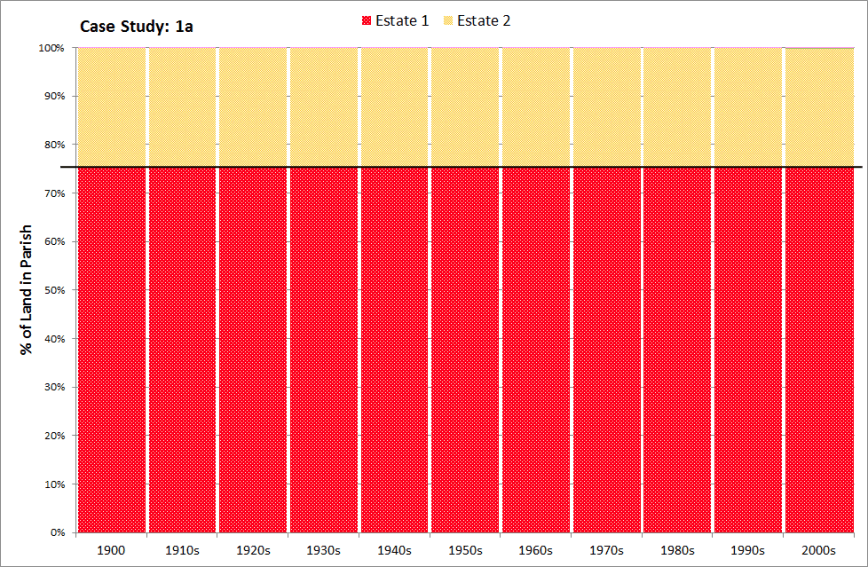
Figure 3 highlights that in case study 1a (unfragmented) the two principal estates have remained intact for over a century. Estate 1 accounts for three-quarters of the parish area, with Estate 2 about a quarter, with only 0.2% of land historically being held outwith these two estates. The only change of ownership by these principal estates occurred in Estate 2 in the 2000s, where there was a new owner of about 8 hectares.
Figure 4 Principal land ownership changes in case study 1b
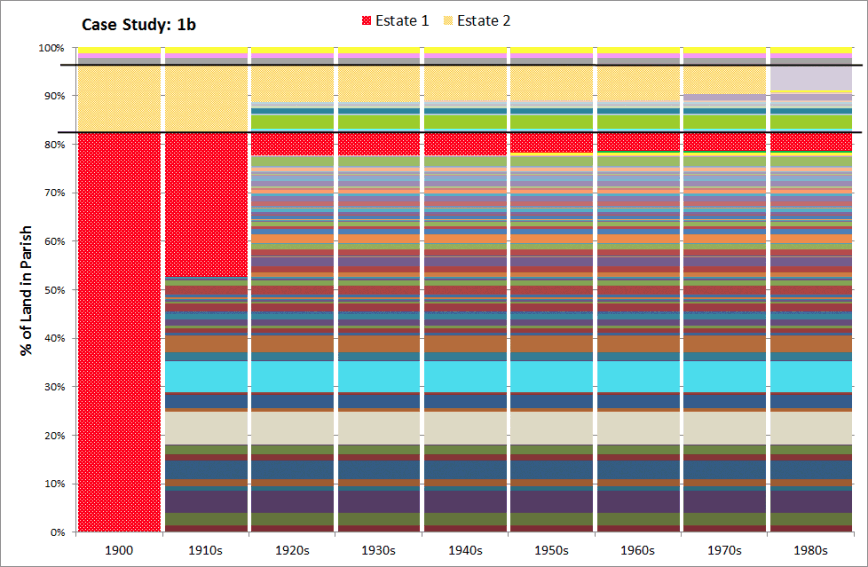
Figure 4 shows how the two principal estates in case study 1b fragmented during the last century, in direct contrast to its paired case study, 1a. In 1900, Estate 1 owned over 82% of the parish whilst Estate 2 owned 14%, with about 3.5% owned by others. In the 1910s, Estate 1 was significantly fragmented, with ownership of 52% of the parish area being transferred to 33 other owners, whilst it maintained ownership of 30% of the parish land. The 1920s saw further break-up of Estate 1 to a further 49 different landowners (many of the ownership transfers related to land parcels of less than 40 hectares), with Estate 1 owning less than 5% of the parish. Estate 2 was also split in the 1920s, with land transferred to 8 other owners, and further fragmentation occurred in the1940s and 1970s, with the remainder of Estate 2 being transferred to new owners in the 1980s. The two principal estates in case study 1b were therefore fragmented into 105 different owners over the 20th century (before further fragmentation or amalgamations took place [28] ).
The focus groups confirmed that Estate 1 was fragmented and sold off in the inter-war period as a result of the owner experiencing financial difficulties during the 1920s depression. This led to more owner-occupied farms, small holdings and private house plots. The principal estate house was originally retained by the family following fragmentation but it was subsequently sold (unknown date) and only about 200 hectares currently remain of the original estate. Since the fragmentation of the main estate there has been only limited changes to the landownership scale, although land has been bought and sold between owners, as well as farmland being sub-let, typically as seasonal lets.
Figure 5 Principal land ownership changes in case study 2a
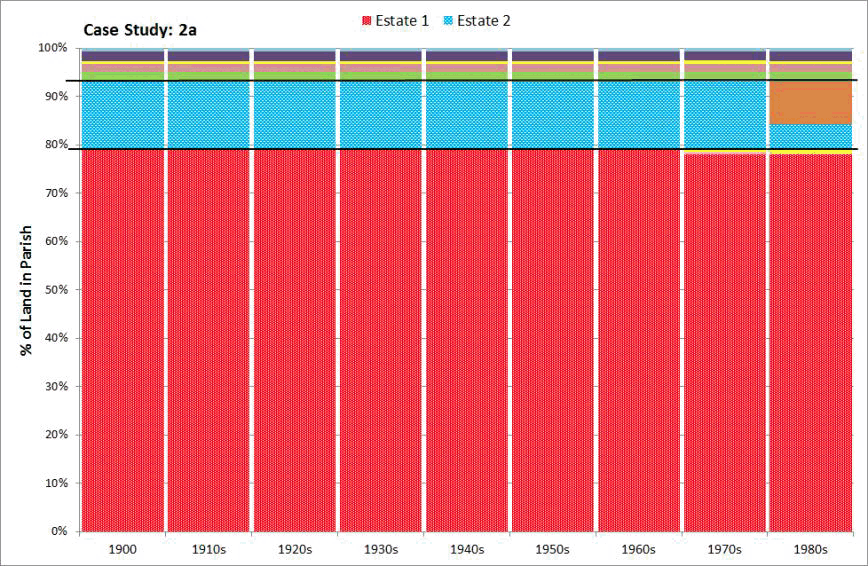
Case study 2a experienced very little fragmentation in the 20th century, as shown in Figure 5. In 1900, Estate 1 owned 79% of the parish area, Estate 2 owned 14%, and 5% was owned by four rural landowners, with 1% made up of the parish's main town. Estate 1 has remained significantly intact since 1900, with only 0.9% of the parish transferred to three new owners in the 1970s and 1980s. Estate 2 remained intact until the 1980s when 62% of it (9% of the parish) was transferred to new ownership.
Figure 6 Principal land ownership changes in case study 2b
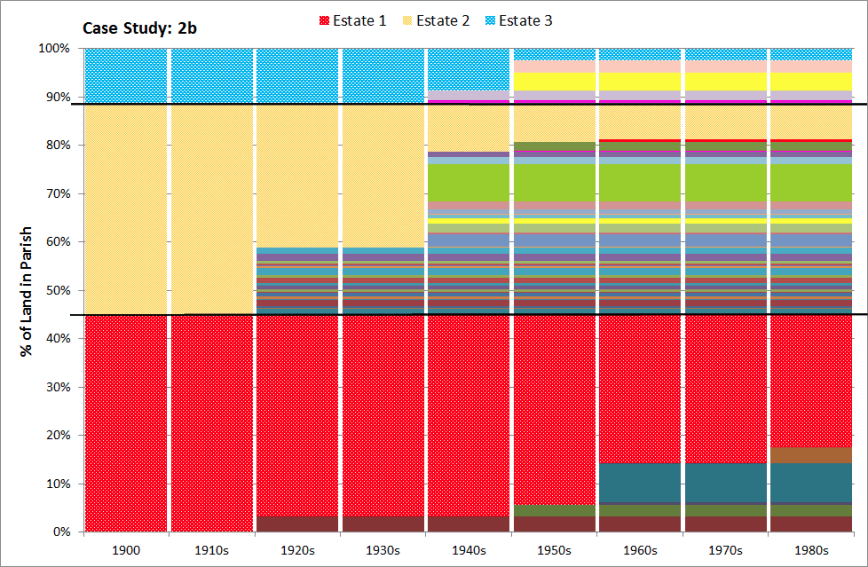
Figure 6 shows how the three principal estates in case study 2b fragmented during the 20th century, in direct contrast to its paired case study, 2a. Up until the 1920s, the parish was owned by three estates: Estate 1 accounted for 51% of the parish, whilst Estates 2 and Estate 3 accounted for 49% and 13% respectively. The 1920s saw about a third of Estate 2 transferred to 28 new owners (parcel size ranging from 2 to 130 hectares), while Estate 1 transferred about 8% of its land holding to a new owner. Estate 2 underwent further major fragmentation in the 1940s to another 14 owners, with further ownership changes in the 1950s and 1960s. Estate 3 was significantly broken up to six new owners in the 1950s and 1960s, with the original estate falling to only 2.3% of the parish area. The 1950s, 1960s and 1980s saw Estate 1 conduct further transfers of land to four new owners but remain the principal land holding in the parish, at 28% of the total area. The three principal estates in case study 2b were therefore fragmented into 60 different owners over the last century (before further fragmentation or amalgamations took place [29] ).
The splitting up of Estate 2 was reported in the fieldwork to have been the result of land sales required to pay death duties, repatriation after the First World War (when land was sold to ex-soldiers upon return to their tenancy), and economic problems in the 1930s when leasing land was uneconomic. Landowners attending the 2b focus group felt that they had benefitted from the demise of the area's estates and the purchase of their tenanted farms. Feedback from the focus group also revealed that following the Estate 2 break-up there was a period of re-amalgamation when the larger, more ambitious, farms bought up smaller, uneconomic units in the quest for economies of scale enabled by mechanisation in agriculture and downstream processing.
Figure 7 Principal land ownership changes in case study 3a
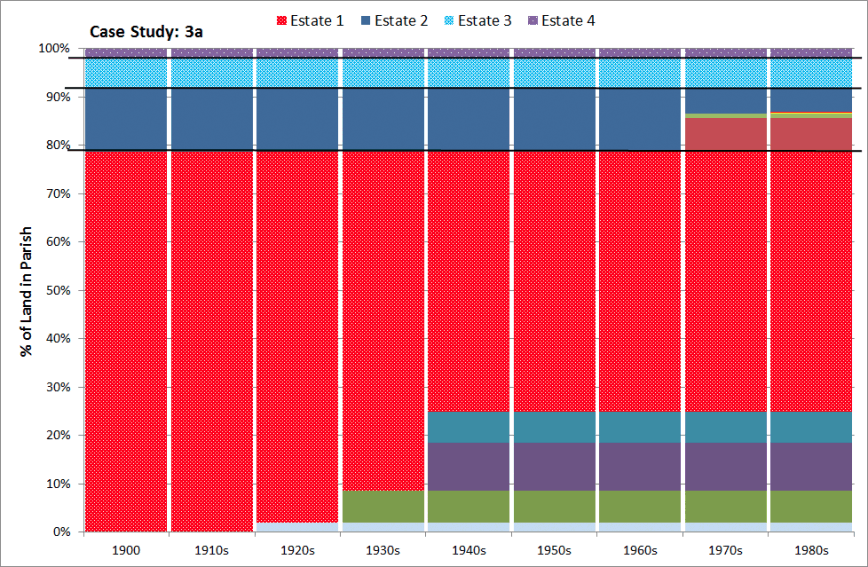
Figure 7 shows how land ownership in case study 3a remained relatively stable over the last century. Up until the 1920s, there were four principal estates (over 1,400 hectares), with the land ownership dominated by Estate 1 (79%) and Estate 2 (13%).
From the 1920s to the 1940s ownership of about 30% of Estate 1 was transferred to four new owners including three land holdings over 4,000 hectares. Estate 2 had 43% of its area transferred to 5 different owners, including 1 holding over 4,000 hectares. Whilst there was some fragmentation of the original estates (from 4 to 12 owners), Estate 1 still currently dominates land ownership in the parish (54% of the land).
Figure 8 Principal land ownership changes in case study 3b
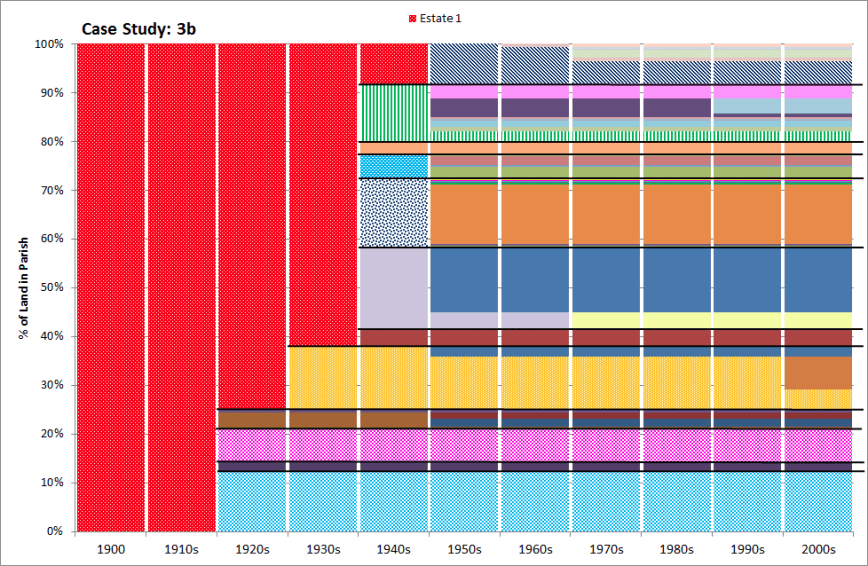
Figure 8 shows how the principal estate in case study 3b was almost entirely fragmented by 1950, in direct contrast to its paired case study, 3a. In the 1920s, a quarter of the estate transferred to 20 other owners (14 of the parcels were less than 3 hectares), including two holdings of over 1,600 hectares. The 1930s saw another large area fragmented off (that was subsequently split further, most significantly in the 2000s). In the 1940s, the majority of the remaining estate area was transferred to another 6 owners (including three holdings over 3,000 hectares). The remainder of the original estate was transferred to a new owner in the 1950s and less than half a hectare remains of this fragmented estate. It is also noticeable that in the 1950s there was significant secondary fragmentation of the landed areas transferred in the 1940s. Over the century since 1900, the solitary estate was significantly fragmented, being split into 77 different owners (before any further fragmentation or amalgamations taking place through subsequent resale by new owners [30] ).
It was noted by a number of fieldwork participants that land value inflation had been significant, particularly in recent years, driven in part by income from sales for housing developments being reinvested and partly by CAP support being capitalised into land values. It was considered that the high land values were a barrier for many to enter agriculture, and the purchase of small holdings. Over the last decade, low interest rates and rapid land price inflation has facilitated continuation of, and reinvestment in, some marginally profitable farm businesses.
Agricultural Holding Size, 1982-2012
Holding-level data from the annual June Agricultural Census ( JAC) [31] revealed that the total area of agricultural holdings differed somewhat between case studies due to farming systems (related to land capability) and to the extent of ownership fragmentation.
Figure 9 Distribution of agricultural holdings under and over 20 hectares 1982 - 2012
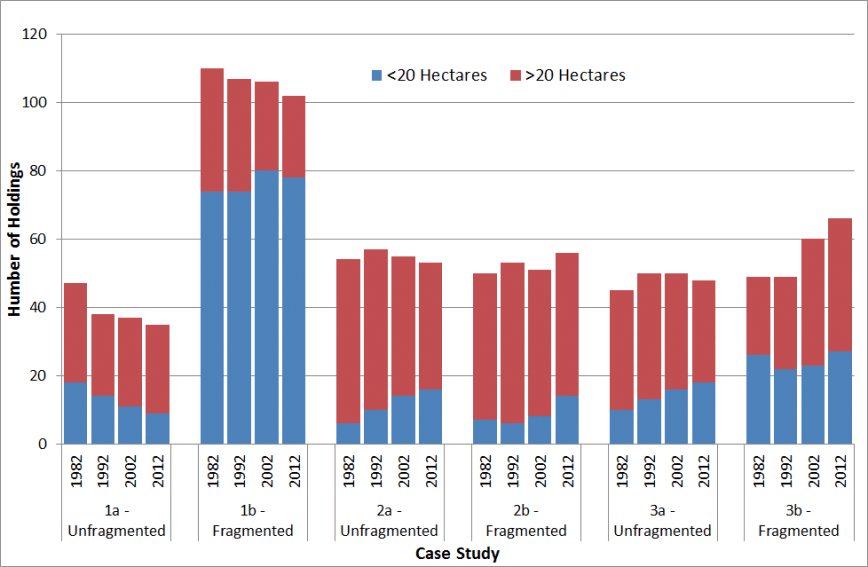
Figure 9 shows that in case study 1b (fragmented) two thirds of holdings were less than 20 hectares in 1982, and whilst this proportion increased to three quarters in 2012 it was largely as a result of a reduction in the total number of holdings. This contrasted with 1a (unfragmented) where the number of holdings under 20 hectares fell between 1982 and 2012. In 1a the total number of holdings fell by a quarter over the period and the fieldwork feedback suggested that this was a direct result of the amalgamation of holdings to create more viable units for tenants or of holdings being taken back in-hand by the estate. This practice of amalgamation of retiring tenanted farms has meant that collectively the number of agricultural holdings in the unfragmented case studies (1a, 2a, 3a) fell by 7% between 1982 and 2012 whereas in the fragmented case studies (1b, 2b, 3b) collectively there were 7% more holdings over the period, perhaps as a result of subdivision of holdings through the sale of land. (see Table 18 Appendix 7 for a full breakdown of the data).
Corresponding to these changes, there were considerably higher numbers of smaller holdings, under 5 hectares, in fragmented case study 1b compared to unfragmented 1a (59 compared to 3 in 2012) that is likely to be a direct result of splitting of units for paddocks, house plots, etc. in this accessible location. Whilst in case study pair 1 there was a clear difference in the number of small holdings between fragmented and unfragmented case studies both case studies 2a and 2b had relatively small proportions of smaller holdings although they increased in number between 1982 and 2012.
In case study 3b, over half the holdings were under 20 hectares in 1982, and whilst there was an increase in total number of holdings by a third between 1982 and 2012 (this may be partially a result of the fragmentation of an estate in the 2000s, as shown in Figure 8) the number of small holdings remained relatively stable. In case study 3a, there was a growth in the number of smaller holdings over the period whilst the total number of holdings remained relatively stable. Overall, it appears that different factors were at play in the fragmented case studies 2a and 3a when compared to 1a where the opposite trend of reduced number of small holdings took place. This may relate to the fact that 1a is the least fragmented case study, and indeed has a much greater proportion of land under agricultural tenure.
In all case studies the fieldwork participants discussed amalgamation of farm units over time to create larger, more economic, farms that benefit from economies of scale. However, coupled with amalgamations, there has been a general trend (with the exception of 1a where land has been subsumed by the estate when tenanted land becomes available) for the number of small "hobby" holdings to stay stable or to rise, often associated with housing sales and paddocks.
Agricultural Tenure
Data from the JAC [32] was used to investigate differences in agricultural tenure across the case studies. In case study 1a, where there has been no significant fragmentation and there are only two major landowners, around 97% of farmland was tenanted until the period between 2002 and 2012 (when the Single Farm Payment was introduced) after which about 18% of the farmland was farmed by the owner. This contrasts with the fragmented case study 1b where in 1982 less than 10% of the farmland was tenanted, although this grew to around 14% in 2012.
In 2a, between 70% and 80% of the land was farmed by tenants which contrasts with 2b, its paired case study, where the amount of land farmed by tenants fell from about 35% in 1982 to only 20% in 2012, highlighting the growing prevalence of owner occupation. 3a is the case study where large landholdings still dominate ownership despite some fragmentation, yet only 20% to 30% of the land was farmed under tenancy arrangements between 1982 and 2012. Between 2002 and 2012 the significant drop in the area of tenanted land in 3b contrasts with the relatively more stable tenure position in 3a.
Figure 10 Tenure of agricultural land, 1982 - 2012
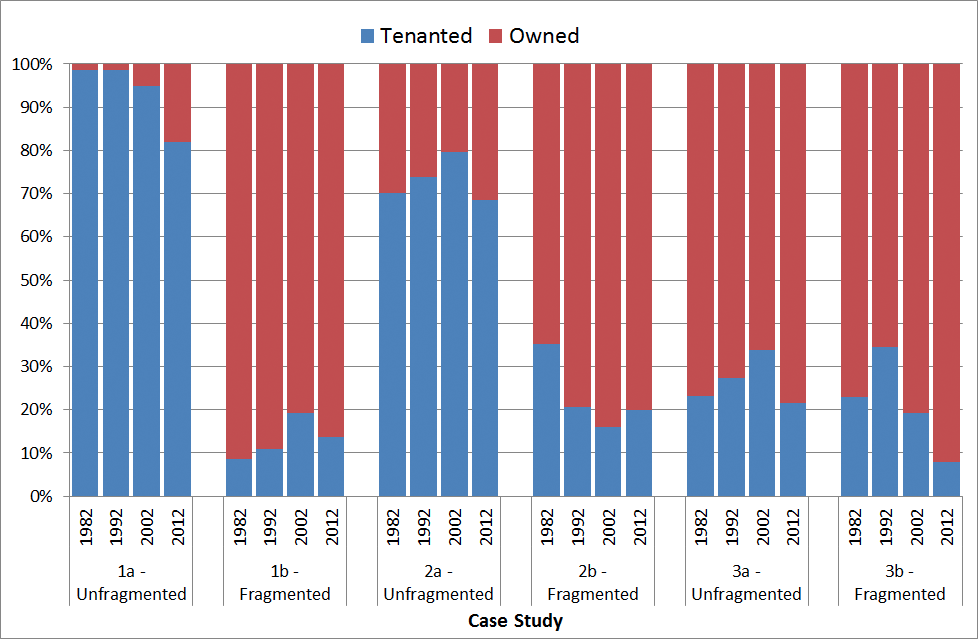
It is apparent that in all of the case studies, with the exception of 2b, there was a sudden decrease in land farmed under agricultural tenure between 2002 and 2012. During this period decoupling of agricultural support occurred and the area-based Single Farm Payment was introduced (in 2005). It was specifically mentioned in the 2a land managers' focus group that over the last decade there has been a notable reduction in estate investment on tenanted farms and the trend to subsume tenanted holdings where possible has often been followed by seasonal letting of the land, thereby avoiding security of tenure issues and access to area-based CAP payments.
In case study 2b, the land managers (who were mostly owner-occupiers) considered that it is more difficult for tenant farmers to access finance than owner-occupiers. They therefore concluded that access to finance is a barrier to tenants' developing or restructuring their business. They suggested that if farming was more efficient, and there were higher market returns, then accessing finance would be easier for tenants and would merit higher rents that could be reinvested by landowners into their holdings. Helping to make farming more efficient and profitable and less reliant on CAP support was seen as being in the best interests of both landowners and tenants alike, as well as potentially reducing fragmentation through sales of plots of land to maintain the farm business.
Feedback from the case studies revealed that the reforms of agricultural holdings legislation coupled with CAP reform have led to some tensions between landowners and tenants, with impacts on long-term strategic development and investment. In recent times, some estates have taken more farmland in hand through absorption of small tenanted holdings when they became economically non-viable, or when a tenant retires. Equally, some tenants have benefited from economies of scale through amalgamations with smaller non-viable units, although it was considered that this policy can restrict opportunities for new entrants, and can be seen as a restriction by those tenants that do not receive an expansion opportunity.
Land manager participants agreed (in both fragmented and unfragmented case studies) that agricultural tenure represents a very good opportunity for getting involved in farming, particularly for those with limited capital. Being given this opportunity by landowners was seen as crucial to 'moving up the farming ladder', but it was perceived that landowner concerns over security of tenure and rights to buy has meant that more owners (including smaller-scale "lifestyle" owners) are utilising contract farming agreements rather than engaging in longer term leases.
Contact
Email: Graeme Beale, socialresearch@gov.scot
There is a problem
Thanks for your feedback